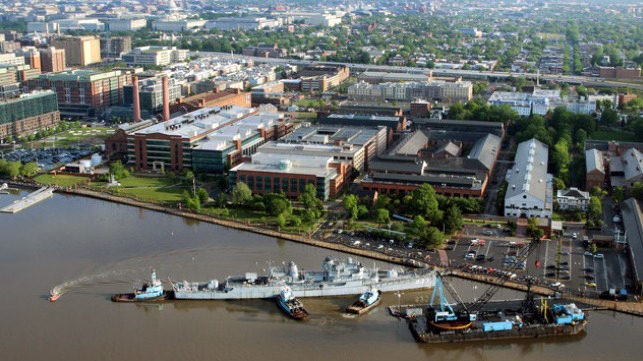The U.S. Navy is contemplating on building a high 14-foot seawall to protect the Navy Yard in Southeast Washington, D.C. from rising sea levels, an effect of climate change.
The Navy Yard is the Navy’s oldest installation. It was established in 1799 as a shipbuilding facility and port, and later used for making ordnance, and then turned into an administrative centre after World War II. The Navy Yard now houses the Chief of Naval Operations (CNO), the Navy’s highest-ranking officer, as well as the Naval Facilities Engineering Command, the Judge Advocate General, and the DoD Navy Inspector General. By proximity, the Navy Yard is less than 2 miles southeast of the U.S. Capitol.
“Military engineers proposed the wall in a study, obtained through a public-records request, that describes a structure as long as 1.5 miles, to protect three dozen buildings at a cost of as much as $20 million. It’s the latest example of a federal agency getting ready for climate change, despite the Trump administration’s public dismissal of the threat,” Christopher Flavelle stated on TaskandPurpose.com.
Bloomberg reports that “The Naval Facilities Engineering Command document, dated 27-February-2018, and based on a flood risk management study prepared for the Navy by the U.S. Army Corps of Engineers, found that a so-called 10-year storm — one with a 10% chance of happening in any given year — would cause 7 feet of flooding at the Navy Yard. A 100-year storm would bring 10.5 feet, and a 500-year storm 14 feet of flooding. Those flood risks will only get worse. The study points out that sea levels are expected to increase 1.3 feet by 2035, and as much as 2.6 feet by 2065. It proposes 5 options to protect the Navy Yard. Four of those options entail surrounding most of site with a permanent wall, as well as pump stations to move whatever water makes it over or around the wall. It proposes a wall with two parts: a permanent 9.5-foot section, topped by removable panels that would rise to 14 feet.”
According to the Union of Concerned Scientists, water levels in the Washington D.C. area will rise much more quickly. With rising sea levels and natural subsidence, water levels along the Anacostia River will rise by 4-6 feet by 2100. This would render parts of the Navy Yard to frequent flooding, and storm surges could lead to more serious damage. The Joint Base Anacostia-Bolling could lose up to 50% of its land.
The water level rise of 4-6 feet would inundate about half of Naval Support Facility Anacostia, which is located just down the Anacostia River. Since the NSF Anacostia is in a Low-lying area, it already experiences close to 40 floods per year. By mid-century, the estimate could rise between 450 and 600 per year, under a worst-case scenario.
It is hoped that the 14-foot wall would address near term everyday flooding and provide adequate capacity to hold back storm surges during extreme weather events. The proposed wall would extend along the site’s waterfront and wrap around along shore to the west. It would separate the Navy Yard from adjoining neighborhoods. However, by separating the Yard, it will put more risk on the nearby structures and make them more vulnerable to flooding. The Navy needs to address this scenario.
“If preventive measures are not taken, the Navy Yard will see more frequent and damaging tidal floods, an increase in the severity of storm-driven floods and a loss of land that is currently being used,” Reem Nadeem reports on WTOP.
The floods would also potentially affect some of the Navy’s most important facilities such as the Navy Military Sealift Command and the Marine Corps helicopters that transport the President of the United States.
REFERENCES:
- Flavelle, Christopher (Bloomberg). “US navy wants to build a wall to stave off climate change.” Straits Times News, 1-February-2019.
- Flavelle, Christopher (Bloomberg). “The Navy Is Building A Wall To Prepare For A Major National Security Threat.” Task and Purpose, 3-February-2019.
- “US navy wants to build a wall to stave off climate change.” MAREX, 11-February-2019.
- Nadeem, Reem. “Navy considers 14-foot wall in Navy Yard to fight rising sea levels.” WTOP, 11-February-2019.
